When this time of year rolls around, my photography instincts wish me back to a little lake in Minnesota that held a small population of some of the most beautiful birds in the world – Wood Ducks. My niece Katy, who is a professional naturalist, tipped me off to the pond and its stunning ducks; so surrounded by colorful autumn leaves, I stood behind sparse shoreline cattail cover and waited for closer approaches by Wood Ducks – with remarkable success.
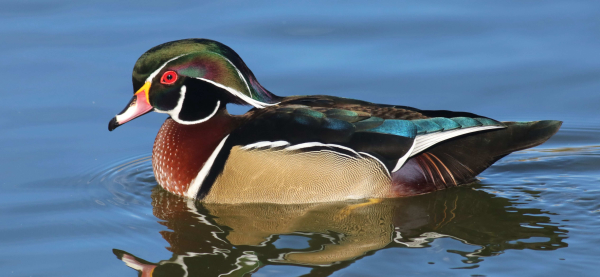
The detail and colors of this drake Wood Duck provided the kind of photo that makes you want to return to that place and time to photograph in the perfect fall light with blue sky reflected in the clear water.
Being in the right place at the right time is what successful bird photography is all about, and while that may happen occasionally out of sheer luck, it’s usually a matter of planning, and reconnaissance. I checked out the location in advance, saw where the Wood Ducks were concentrated, assessed the area to determine the best time of day to visit to take advantage of the best lighting, and even approached a few ducks to get an idea of how wary the Woodies were.
Mid-morning the next day, with the sun at my back and Wood Ducks positioned in front of me, I enjoyed a couple hours photographing. I appreciated the chance to take many nice portraits of female and drake Wood Ducks on the water. It was exciting to be in position to appreciate the birds in close quarters, and I so enjoyed hearing the Woodies voice their whistling calls throughout the period.
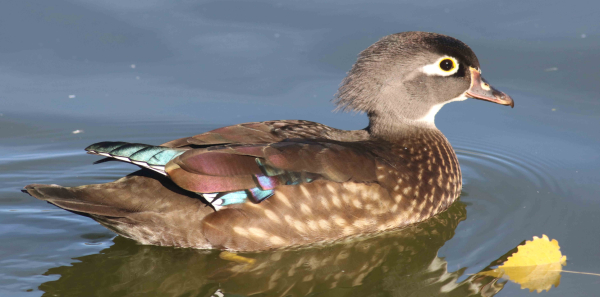
The colors of a female Wood Duck have a more subtle beauty, while the lone yellow cottonwood leaf adds a touch of the autumn season.
Of course, the vibrant iridescent colors of drake Wood Ducks are famous, but in person they are stunning. It’s impressive to see how the varied hues of color change as a Woody turns its head or swims in different directions – Wow! So it was great to try to get different lighting angles on birds to try to get different rainbow reflections of the light on their specialized feathers. After being overwhelmed by the bright iridescent colors of the males, I concentrated on the equally beautiful females with beautiful wing colors as well as the tan and gray shades of their plumage broken by tan spots and white eye rings and throat – and they are cute too.
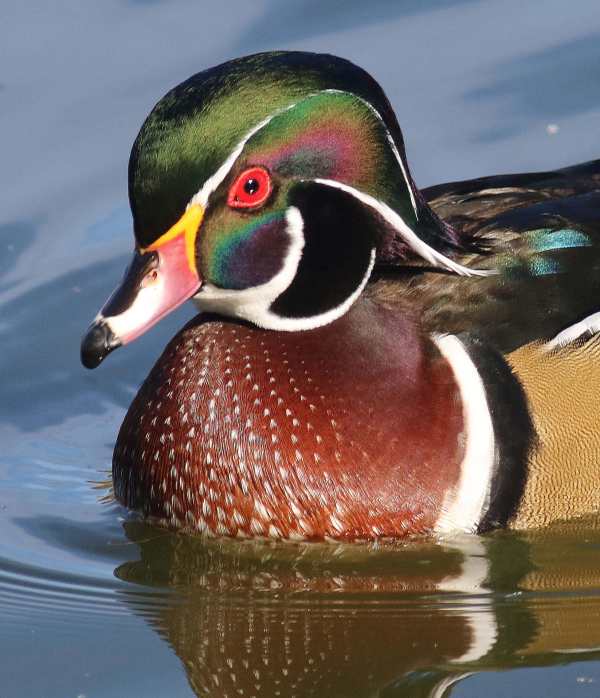
It’s quite rare to get a close portrait of the face of a drake that reveals the full rainbow of colors and the sweep of the stylish crest feathers, accented by its colorful bill and striking red eye.
|
Photographing Wood Ducks swimming is very similar to photographing any swimming or wading birds surrounded by water. Trust your light meter, and be aware of the reflection of the bird in the water, which shows up as a mirror image below the bird. It can be worthwhile to frame the bird with ample space below it, so you get images that show the reflection, especially if it is a windless still day.
Also be aware of the color of the water reflection; it may be blue if it is reflecting a clear blue sky; it may be green if reflecting cattails or other green plants, or it may be yellow if the leaves have turned color with autumn’s magic. All of these options can be nice, so when you have the chance, photograph the ducks with a variety of reflected colors and see what looks best during your photo review process.
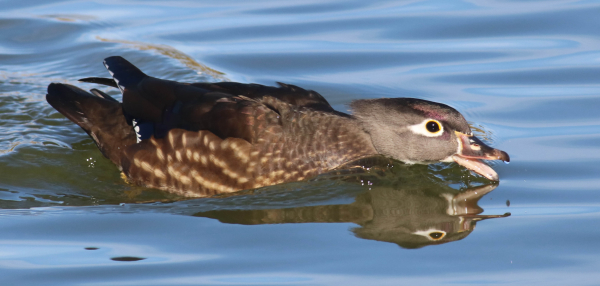
A female Wood Duck making an aggressive lunge at another duck provided an opportunity for an action photo.
|
Although I certainly appreciated being so close and getting nice portraits, I also hoped for some action photos. I tried to anticipate when Woodies would rise up and flap their wings, and started concentrating on ducks in flight. Both options were pretty rare though, and I didn’t have very good luck with either of these action photo options.
I also tried to get photos of more than one Wood Duck in a frame – a female and male pair, or a couple males in proximity – maybe even with a little aggressive behavior between them. But again, I had poor luck with that plan too. But that’s the way bird photography works, you give it a try, get the best photos you can, and any photo ops that weren’t forthcoming or successful during one photo session, may be the rule during your next opportunity. It becomes a reason to return.
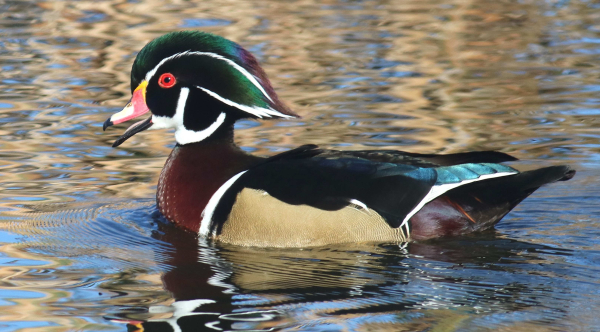
An option to the blue water settings was presented when the alert and calling drake slipped into an edge of the pond that reflected yellowed vegetation.
|
If you are only photographing one bird, you can use almost any aperture ranging from f5 to f14, but when you’re photographing in good sunlight it’s probably best to take a middle route and stick with a standard f8 in case a pair of Wood Ducks flies by. At the same time, if the action is relaxed, you can certainly switch to an f11 or f14 to ensure more depth of field when a second bird swims into the scene. Just remember what aperture setting you are working with as you change f-stops so you can adjust back to your preferred setting. If you’re working in the Av mode (aperture priority mode) – which I always recommend – the shutter speed will be automatically matched with the f-stop you choose with reference to the current light conditions.
One of the pluses about photographing during autumn is that there are no mosquitos to contend with, and no sweat dripping down your face. The air is fresh, the birds are active, and the direction and angle of the light is good for photography during a longer period of time. Actually though, any time you are in the company of Wood Ducks with your camera in hand, you know it’s prime birding time, especially when you take some memorable photographs. Enjoy these weeks of fall color, and enjoy the birds around you!
Article and photographs by Paul Konrad
Share your bird photos and birding experiences at editorstbw2@gmail.com